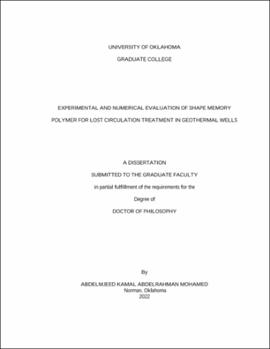| dc.description.abstract | Lost circulation presents formidable challenges to drilling operations, especially in high-temperature and fractured formations. Lost circulation events increase the nonproductive time (NPT) and the total cost of drilling operations. In some severe cases of complete or high losses, well control is jeopardized, leading to a loss in lives and resources. Besides the conventional lost circulation materials (LCMs), LCM pills, and cement squeeze, several innovative solutions have been introduced to mitigate and treat the lost circulation events, including wellbore strengthening, managed pressure drilling (MPD), and casing while drilling (CwD). However, selecting the suitable LCM and the optimized fluid formulation is vital to the lost circulation remedy's success.
The primary objective of this study is to evaluate the effectiveness of smart material in treating lost circulation in geothermal formations. The smart material is a shape memory polymer (SMP) that can be programmed to activate by formation temperature. Once activated, its particle size increases to plug large fractures and stop mud losses. SMP evaluation is conducted on a large-scale flow loop under high-temperature conditions (above 300℉). The experimental evaluation includes SMP activation with temperature, fluid rheology, wellbore hydraulics, fracture sealing, and SMP transportation in the annulus under a broad range of operating parameters, such as concentration, drill pipe rotational speed, inclination angle, and flow rate. Furthermore, a computational fluid dynamics (CFD) study was conducted to upscale the experimental results and predict the LCM transportation in the annular section of geothermal wells in the field dimensions.
The novelty of this study is the use of shape memory polymer that has the potential to plug large fractures in geothermal formations with minimal risk of plugging downhole drilling and logging tools. Moreover, this study introduces a novel experimental setup to test different lost circulation materials under high-temperature conditions. The introduced large-scale testing is unique and crucial in LCM evaluation to ensure better results in geothermal fields. | en_US |
